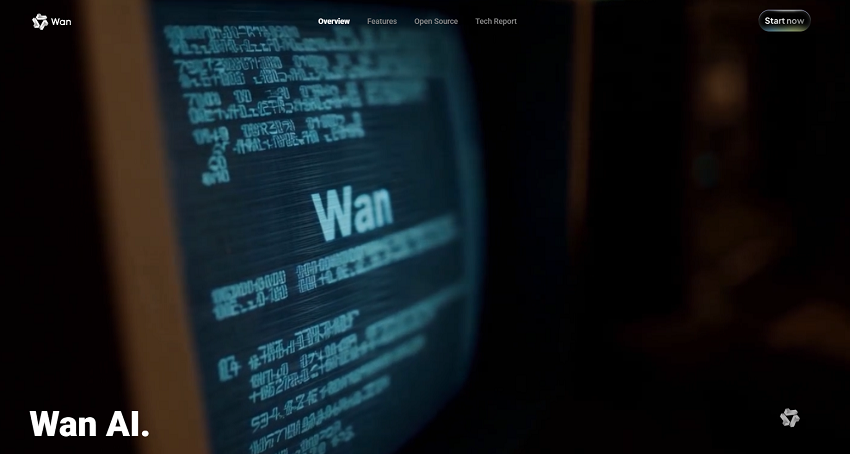Wan 2.1 is Alibaba's latest leap into AI video generation—an open-source, multimodal model designed to rival even the likes of OpenAI's Sora. In this Wan 2.1 AI video review, we'll take a deep dive into what makes this model stand out: from text-to-video and image-to-video capabilities to real-time editing and sound-sync features. It's built for AI enthusiasts, content creators, and developers who want flexible, high-quality video generation that runs on consumer GPUs. But how well does it actually perform in real-world scenarios? Is it worth your time—and your VRAM? Let's break it down.
What Is Wan 2.1
Wan 2.1 is a cutting-edge, open-source AI video generation model developed by Alibaba's Institute for Intelligent Computing. Designed as a direct challenger to models like OpenAI's Sora, Wan 2.1 supports text-to-video (T2V), image-to-video (I2V), and even video editing and sound-synchronized generation—all within a single unified framework. What sets it apart is its accessibility: unlike many closed-source models, Wan 2.1 is freely available under the Apache 2.0 license and can run on consumer GPUs with as little as 8GB of VRAM. Backed by a powerful Diffusion Transformer architecture and WAN-VAE compression, it produces high-fidelity, temporally coherent videos at resolutions up to 1080p. The release of Wan 2.1 marks a major step forward in democratizing advanced generative video tools for researchers, developers, and everyday creators alike.

Wan 2.1 AI: Key Features & Innovations
Wan 2.1 isn't just another text-to-video model—it's a comprehensive, open-source video generation framework packed with advanced features that push the boundaries of what AI can create. Below are the standout innovations that make Wan 2.1 one of the most powerful generative video tools available today:
1. Multimodal Generation
Supports text-to-video (T2V), image-to-video (I2V), frame-interpolated video editing, and even video-to-audio synchronization, all within a unified framework.
2. High-Resolution Output
Capable of generating videos up to 1080p using high-parameter models like I2V-14B-720p and T2V-14B, with improved spatial and temporal consistency.
3. Efficient on Consumer Hardware
Surprisingly lightweight, Wan 2.1 can run on GPUs with just 8GB VRAM—making it far more accessible than many of its closed-source competitors.
4. Advanced Architecture
Built on a Diffusion Transformer backbone and WAN-VAE compression module, enabling realistic motion, accurate object rendering, and minimal frame artifacts.
5. Fine-Grained Prompt Control
Users can guide generation using spatial-temporal prompts and shift-based motion tuning for greater customization and scene coherence.
6. Sound-Sync Support
Some variants enable generating videos with sound-aligned lip sync and motion rhythm—ideal for talking avatars and narrative content.
7. Open-Source Advantage
Released under the Apache 2.0 license, Wan 2.1 allows developers to freely integrate, modify, and build upon the model for research or commercial projects.
These innovations make Wan 2.1 not just a tech demo, but a practical and powerful tool for next-generation video content creation.
How to Use Wan 2.1
Getting started with Wan 2.1 is easier than you might think, especially given its open-source nature and compatibility with consumer GPUs. Here's a step-by-step breakdown of how to use Wan 2.1 AI for generating videos:
Step 1. Clone the official Wan 2.1 repository or download from Hugging Face or GitHub.
Step 2. Install dependencies:
- Python 3.9+
- PyTorch (with CUDA support)
- Required Python packages (listed in requirements.txt)
Step 3. Download the pre-trained model checkpoints.
Step 4. (Recommended) Install ComfyUI for a node-based visual interface, with Wan 2.1 workflows already integrated.
Step 5. Launch ComfyUI or run scripts directly to start generating videos from text or image prompts.
Step 6. Adjust settings like:
- Frame rate and resolution (e.g., 720p or 1080p)
- Motion shift and interpolation
- Prompt weighting and guidance scale
💡 Bonus Tip: Enhance Wan 2.1 Videos with Aiarty Video Enhancer:
While Wan 2.1 produces impressive video content, its raw outputs can sometimes appear soft, low-resolution, or noisy—especially when generating at 720p or on limited VRAM setups. To take your AI-generated videos to the next level, consider running them through Aiarty Video Enhancer as a post-processing step.
- Upscale to 4K or 8K: Aiarty leverages advanced AI models to boost resolution without introducing artifacts or blur—making your videos suitable for YouTube, client presentations, or large screens.
- Clarity & Sharpness Restoration: It enhances fine textures, facial features, and edges that might look fuzzy in Wan 2.1's native output.
- Noise Reduction (Video & Audio): Removes grain, motion-induced video noise, and unwanted background noise in the audio track, resulting in cleaner visuals and clearer sound.
- Frame Interpolation: Smooths motion by generating additional frames between existing ones, making videos less choppy and ideal for slow-motion effects or higher frame rate playback.


Wan 2.1 AI Performance Benchmarks
Wan 2.1 has quickly gained attention for its impressive performance across multiple video generation benchmarks, positioning itself as one of the most capable open-source AI video models available today. Here's a closer look at its key benchmark results and how it stacks up against competitors:
1. VBench Leaderboard
Wan 2.1 consistently ranks near the top on VBench, a leading video generation evaluation metric. It achieves a score exceeding 84.7%, demonstrating strong temporal coherence, object accuracy, and scene realism. This high score reflects Wan 2.1's ability to produce videos with smooth motion and consistent visual quality frame-to-frame.
2. Generation Speed
Runtime: On a consumer-grade GPU (such as an NVIDIA RTX 3090 with 24GB VRAM), Wan 2.1 can generate approximately 15 seconds of video per minute of processing time.
This speed is competitive given its open-source status and high output quality, though it is slower than some cloud-based proprietary models.
3. Resolution & Quality
Capable of producing videos up to 1080p resolution (with T2V-14B and I2V-14B models), offering detailed textures and clear object boundaries.
Lower-parameter models generate at 480p or 720p but maintain acceptable quality for most use cases.
4. Multimodal Accuracy
Wan 2.1 excels at both text-to-video and image-to-video tasks, with superior object fidelity and scene consistency compared to earlier models.
The model demonstrates strong performance in complex scenes involving multiple moving objects and diverse backgrounds.
Real World Use Cases & User Reviews
Since its release, Wan 2.1 has been embraced by a growing community of AI enthusiasts, developers, and content creators who are exploring its potential across diverse applications. Here's how Wan 2.1 is making an impact in the real world, along with honest feedback from users:
1. Creative Content Generation
- Short Films & Animation: Filmmakers and animators use Wan 2.1 to prototype scenes, create visual effects, and generate storyboards, significantly speeding up early-stage video production.
- Social Media & Marketing: Content creators leverage Wan 2.1's text-to-video features to produce engaging clips and promotional videos with minimal resources.
- Virtual Avatars & Talking Heads: The model's sound-synchronized video capabilities enable the creation of lifelike avatars for streaming and customer service bots.
2. User Reviews & Community Feedback
- "Wan 2.1 is a game-changer for open-source video AI. The quality rivals some paid cloud services, and the fact that I can run it locally is amazing." — Reddit user, AI content creator
- "I tested Wan 2.1 on my RTX 3090, and while it requires patience, the results are stunning—especially for complex scenes with multiple moving objects." — GitHub contributor
- "The ability to generate videos from images is impressive, though I noticed it needs some fine-tuning to avoid occasional frame glitches." — AI researcher, Hugging Face forum
3. Challenges & Limitations
Some users report that Wan 2.1 can be VRAM-intensive, limiting smooth generation on lower-end GPUs.
Generation speed may not yet match commercial cloud platforms, especially for longer videos.
As with many generative AI models, occasional artifacts or inconsistencies can appear, requiring prompt tuning or post-processing.
Comparison Table: Wan 2.1 vs Alternatives
Pros & Cons
- Wan 2.1 is fully open-source under the Apache 2.0 license, allowing anyone to download, modify, and use it without cost.
- Supports text-to-video, image-to-video, video editing, and audio synchronization—all in one unified model.
- Optimized to work on GPUs with as little as 8GB VRAM, making it accessible to hobbyists and small teams.
- Produces videos up to 1080p with impressive temporal coherence and object fidelity.
- Allows fine-tuning with prompt guidance, motion shifts, and frame interpolation for more personalized results.
- Backed by a vibrant GitHub and Hugging Face community, enabling rapid improvements and user support.
- While reasonable for open-source software, video generation can take several minutes per clip on typical hardware.
- Requires a relatively powerful GPU (8GB+ VRAM), limiting accessibility for users with low-end devices.
- Some outputs may contain visual glitches or inconsistent frames, needing prompt tuning or post-processing.
- As a rapidly evolving open-source project, official guides and tutorials are sparse compared to commercial tools.
- Users must run Wan 2.1 locally or find third-party hosting, which can be a barrier for non-technical users.
 FAQs
FAQs
Yes, Wan 2.1 is released under the Apache 2.0 license, making it free to download, modify, and use for personal or commercial projects.
A GPU with at least 8GB VRAM (such as NVIDIA RTX 3060 or above) is recommended for smooth video generation. Higher VRAM improves resolution and speed.
On a typical consumer GPU, generating about 15 seconds of video can take approximately one minute, depending on resolution and complexity.
Currently, Wan 2.1 supports up to 1080p resolution. For higher resolutions like 4K, post-processing with tools like Aiarty Video Enhancer is recommended.
Definitely! Using AI video enhancers like Aiarty Video Enhancer can upscale resolution, denoise video and audio, perform frame interpolation, and improve overall quality.